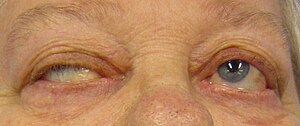Erb-Goldflam syndrome
| Myasthenia gravis | |
|---|---|
 |
|
| Eye deviation and a drooping eyelid in a person with myasthenia gravis trying to open her eyes | |
| Specialty | Neurology |
| Symptoms | Varying degrees muscle weakness, double vision, drooping eyelids, trouble talking, trouble walking |
| Usual onset | Women under 40, men over 60 |
| Duration | Long term |
| Causes | Autoimmune disease |
| Diagnostic method | Blood tests for specific antibodies, edrophonium test, nerve conduction studies |
| Similar conditions | Guillain-Barre syndrome, botulism, organophosphate poisoning, brainstem stroke |
| Treatment | Medications, surgical removal of the thymus, plasmapheresis |
| Medication | Acetylcholinesterase inhibitors (neostigmine, pyridostigmine), immunosuppressants |
| Frequency | 50 to 200 per million |
| Classification |
· ·
|
|---|---|
| External resources |
|
Myasthenia gravis (MG) is a long-term neuromuscular disease that leads to varying degrees of skeletal muscle weakness. The most commonly affected muscles are those of the eyes, face, and swallowing. It can result in double vision, drooping eyelids, trouble talking, and trouble walking. Onset can be sudden. Those affected often have a large thymus gland or develop a thymoma.
Myasthenia gravis is an autoimmune disease which results from antibodies that block or destroy nicotinic acetylcholine receptors at the junction between the nerve and muscle. This prevents nerve impulses from triggering muscle contractions. Rarely, an inherited genetic defect in the neuromuscular junction results in a similar condition known as congenital myasthenia. Babies of mothers with myasthenia may have symptoms during their first few months of life, known as neonatal myasthenia. Diagnosis can be supported by blood tests for specific antibodies, the edrophonium test, or a nerve conduction study.
Myasthenia gravis is generally treated with medications known as acetylcholinesterase inhibitors such as neostigmine and pyridostigmine.Immunosuppressants, such as prednisone or azathioprine, may also be used. The surgical removal of the thymus gland may improve symptoms in certain cases.Plasmapheresis and high dose intravenous immunoglobulin may be used during sudden flares of the condition. If the breathing muscles become significantly weak, mechanical ventilation may be required.
...
Wikipedia
